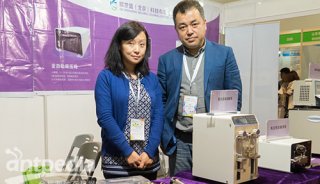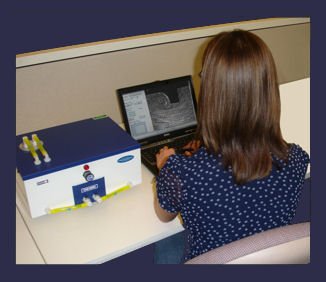Combined Flow Cytometric Measurement of Two Cell-Surface Antigens-2
DNA and RNA Staining
6. Stain cells with 7-AAD:
i. Resuspend the cells from Step 5 in 0.5 mL of NASS containing 10 µg/mL of 7-AAD. Incubatefor 20 min at 20°C-25°C, protected from light.
ii. Prepare a cell sample that is stained only with 7-AAD (without any cell surface staining).
This sample is necessary to determine the amount of fluorescence overlap of 7-AAD into other detectors on the flow cytometer and to set the appropriate fluorescence compensation.
7. Add 1 mL of 1X PBS to each sample. Collect the cells by centrifugation at 250g for 5 min. Discard the PBS.
8. Stain cells with PY:
i. Resuspend each cell pellet in 0.5 mL of NASS containing 10 µg/mL of AD. Place the mixtureon ice for 5 min, protected from light.
ii. Add 5 µL of a 1:10 dilution of the PY stock solution (made with H2O), and vortex immediately. Keep the cells on ice, protected from light, for at least 10 min before sample acquisition on the flow cytometer.
It is possible to keep cells in the staining solution protected from light at 4°C for a maximum of 3 d before sample acquisition on the flow cytometer, without adverse effects.iii. Prepare a sample of cells stained only with PY (without any cell-surface or 7-AAD staining).
This sample is necessary to determine the amount of fluorescence overlap of PY into other detectors on the flow cytometer and to set the appropriate fluorescence compensation.
9. Run samples on the flow cytometer using a low sample differential. Collect the fluorescence signals for cell-surface immunofluorescence with log amplification. Collect the DNA and RNA signals with linear amplification (Fig. 1 ).

View larger version (24K):
[in this window]
[in a new window]
Figure 1. Application of the method for concurrent flow cytometric measurement of two cell-surface antigens and DNA-RNA content. Human peripheral blood mononuclear cells were cultured for 72 h, either in medium alone (A-D) or in medium containing 100 ng/mL of soluble CD28.2 (Biodesign) in the presence of 100 ng/mL of surface-bound OKT3 (Ortho Diagnostics) (E-H). (C and G) Analysis of CD5+CD8+ T cells; RNA/DNA dot-plots were gated on scatter as shown in row 1 (in A and E) and R1 (in B) or R2 (in F), respectively. (D and H) Analysis of CD5-CD8+ cells; RNA/DNA dot-plots were gated on scatter as shown in row 1 (in A and E) and on R3 (in B) or R4 (in F), respectively. After 3 d in culture without stimulation, CD8+ cells, irrespective of CD5 expression, did not leave G0. As expected, with CD3/CD28 activation, CD8+ cells that coexpressed CD5 (a human T lymphocyte antigen) proliferated, while CD5-CD8+ (NK cells) remained in G0. After 72 h of costimulation, only 9% of CD5+CD8+ T cells remained in G0; ~15% were in G1a, 21% were in G1b, and the rest were represented in the S + G2+M phases of the cell cycle. Running samples at a low sample pressure lowers the coefficient of variation (CV) of the DNA measurement. Low CVs improve the accuracy of data analysis by facilitating deconvolution of DNA histograms by flow cytometry DNA analysis software programs. See Troubleshooting.
A standard practice employed for reliable DNA analysis is doublet discrimination. This can be achieved by acquiring area and width signals in the channel used for measuring DNA fluorescence. If this is not possible due to instrument limitations, displaying area versus height signals or gating on light scatter signals (Fig. 1) can also be used to exclude cell aggregates during data analysis.
TROUBLESHOOTING
Problem: The DNA profiles have a high CV.
[Step 9]
Solution: The low pH of the NASS improves access of 7-AAD to the DNA, resulting in DNA staining with low CV. Despite this, samples that are run through the flow cytometer at high sample pressure will be measured with decreased precision and higher CVs. In addition, there is fluorescence overlap between 7-AAD and PY. If the overlap is not compensated correctly, the 7-AAD peaks will widen. Also, if substantial numbers of cells are dying, their degrading DNA will lead to broad DNA distributions. Solutions involve removing dead cells by Ficoll gradient orchoosing an earlier time point for analysis (before the cells start to die).
Problem: The detection of cellular subpopulations needs improvement.
Solution: This protocol was optimized for detection of surface antigens by using low nucleic acid dye concentrations and exchanging 7-AAD with nonfluorescent AD. This serves to reduce background fluorescence caused by the dyes in solution and to minimize fluorochrome interactions. Data obtained with these low concentrations matched the results obtained for DNA-RNA staining with standard concentrations of 7-AAD and PY. Therefore, because nucleic aciddye concentrations must be maintained at the levels described in the Method section, strategies to improve the brightness of signal detection should focus on the mAb staining step (Step 2). These strategies involve selecting the brighter fluorochrome for the cell-surface antigen with low abundance, titrating the mAb to achieve the best separation between background and positivecells, using indirect staining to amplify the fluorescent signal, and selecting different mAb clones that may provide better staining.
DISCUSSION
In mixed-cell preparations, analysis of surface antigen expression in combination with cell-cycle events is essential for the determination of the growth status of cellular subpopulations. Measurement of DNA content by flow cytometry using different fluorescent dyes for staining DNA is compatible with simultaneous detection of cell surface antigens, but only identifies the three basic phases of the cell cycle: G0/1, S, and G2+M. Cells that are actively progressing through the S phase can be identified in flow cytometry by combining measurement of DNA content with bromo-deoxyuridine (BrdU) incorporation, an assay comparable to the assessment of thymidine incorporation using a radioactive label. However, the DNA denaturation step required in many BrdU staining protocols to make incorporated BrdU accessible to anti-BrdUantibodies can affect simultaneous detection of other immunochemical parameters. Bivariate analysis of DNA content and cyclin expression, which varies during cell-cycle progression, provides a framework for the subdivision of the cell cycle into distinct subcompartments. The success of this technique relies on suitable cell-fixation, cell-permeabilization, and dependable antibodies specific for the various types of cyclin proteins that have been proven to work in flow cytometry.
In addition to DNA content, the determination of RNA content is another approach for assigning cells to various cell-cycle compartments and for discriminating G0 from different stages within G1. Several techniques have been developed for DNA-RNA content measurement by flow cytometry. One method involves differential staining of DNA-RNA with acridine orange (AO) (Darzynkiewicz et al. 1980). Accurate measurement of DNA-RNA content using AO is rather complex and depends on stringent staining conditions. In addition, AO, due to its broad emission spectrum, cannot be combined with other common fluorochromes used for antibody labeling. Another method is the simultaneous analysis of DNA and RNA content using Hoechst 33342 and PY (Shapiro 1981). This assay requires ultraviolet excitation, which is not available on most benchtop flow cytometers. Alternatively, Toba et al. (1995) described a 7-AAD/PY DNA-RNA staining method that is compatible with cell-surface antigen staining with fluorescein-isothiocyanate (FITC)-labeled antibodies.
This protocol describes a method optimized for the concurrent measurement of two cell-surface antigens using a standard dual-laser flow cytometer. Cell-surface staining is presented using oneantibody that is directly labeled with APC, and a second, biotinylated antibody that is detected with Alexa Fluor 488-labeled streptavidin (Fig. 1). If a given cell-surface antigen is expressed at high levels, mAbs that are directly conjugated to Alexa Fluor 488 can be used, shortening the time required for staining. Conversely, it is possible to use one unlabeled mAb that is then detected with a fluorochrome-labeled species-specific antiserum. This strategy can be used to amplify the signal obtained with low-abundance cell-surface antigens. Note, however, that for dual cell-surface labeling, the first and second staining steps for the unlabeled mAb need to be completed before staining with the other, directly labeled mAb. Otherwise, the antiserum will bind to both mAbs (unless each was made in a different species).
New fluorochromes have recently become available for flow cytometry that may be compatible with this protocol. The selection of fluorochrome labels for cell-surface staining with emissionsthat can be separated from the emissions of 7-AAD (peak emission at 650 nm) and PY (peak emission at 580 nm) is necessary. The fluorochromes must also be compatible with the acidic NASS solution (pH 4.8). For instance, fluorescein isothiocyanate (FITC) cannot be used, because FITC fluorescence is lost in acidic solutions. Before new labels are incorporated into this staining protocol, it is necessary to determine whether they retain sufficient brightness for detection of a given cell-surface antigen.





















